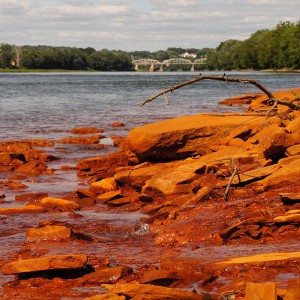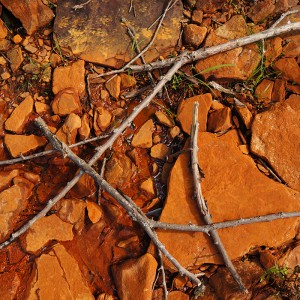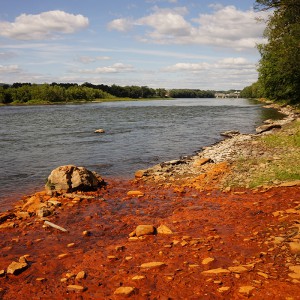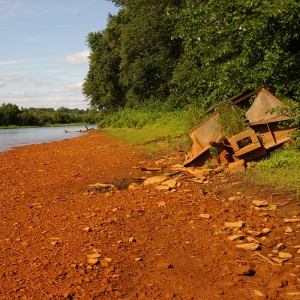Knox Mine disaster [Coal]




Physical and cultural impacts:
In January 1959, miners working the coal mine through the Pittston bed beneath the Susquehanna River compromised the riverbed. The ice-heavy river broke through its dangerously thin bed and drained into the Knox Mine. Although mining operations were legally restricted within 35 feet below the riverbed, by the day of the disaster, the Pittston bed had been excavated to within 2 feet below the river. Twelve men are entombed in the mine.
Though the mine is now sealed off, ground water continues to flow and seep through the old shafts and emerge into the Susquehanna. When water flows through coalmines, it dissolves the coal, releasing sulphuric acid. The acid reacts with soluble iron in the river, producing a yellow-orange material commonly called yellow boy.
From top:
Top two: yellow boy covers the rocks, banks, river bed of the Susquehanna; third image: the line between acid mine drainage and natural river is clear; bottom: a box car, driven into the mine in 1959 in an attempt to plug the riverbed, missed the sinkhole and now sits beside the river bank.
A few corrections and relevant points:
The Knox Mine Disaster took place on January 22, 1959, not in 1952.
The mining that compromised the river bed took place in an anticline, which contained very rich coal with little to no rock, making extraction and processing relatively quick and easy. The anticline was in an area of the mine that had been marked as off limits on mine maps, as no borehole study had been done at the top of the anticline to determine whether the rock cover above it was sufficient to support the heavy overburden of sediment and riverwater. On January 13th, a mine inspector ordered the cessation of mining in the anticline. The order was interpreted to mean that mining should cease at the end of their shift, and the asst foreman and crew proceeded to mine several additional cars of coal. To clarify your account, no miners were extracting coal at the site of the break-in on the day of the disaster. The break-in happened nine days after the last loads of coal had been taken. However, there were workmen in that area of the mine on January 22nd and a few of these were among the twelve who died that day. Eighty-one men were in the mines when the water broke in. Most were fortunate to escape, either immediately, or after many perilous hours searching through the vast honeycomb of chambers and tunnels for the Eagle Air Shaft, by which 33 eventually escaped. My dad was the first to meet the first miner to escape via the air shaft and participated in the rescue of the remaining…
Another fact check: The box car seen in your photo flowed past the vortex at the site of the break-in, having missed its target. Several other gondolas were more successfully aimed, though they probably had the effect of scouring the sides of the vortex, thus widening it, rather than staunching the violent flow of water into the mines. Presumably those cars remain underground.
Fact check: You might want to consult a hydrogeologist with knowledge of the location or folks at EPCAMR as to whether “river water” flows through the mines. Some may but….Anthracite mines had pumps and tunnels to manage the ongoing seepage of ground water into mines, most of which were not under the river. As I understand it, with no pumping, the abandoned mine works have caved and filled with ground water, which in turn seeps into the river as yellow boy. The site of the river break in was sealed.